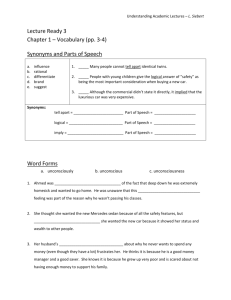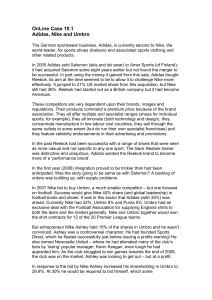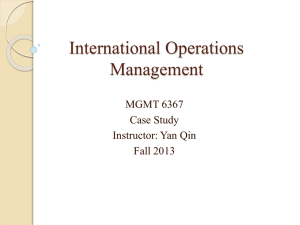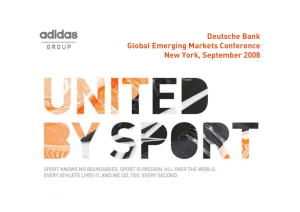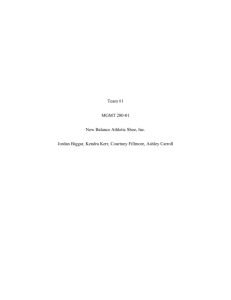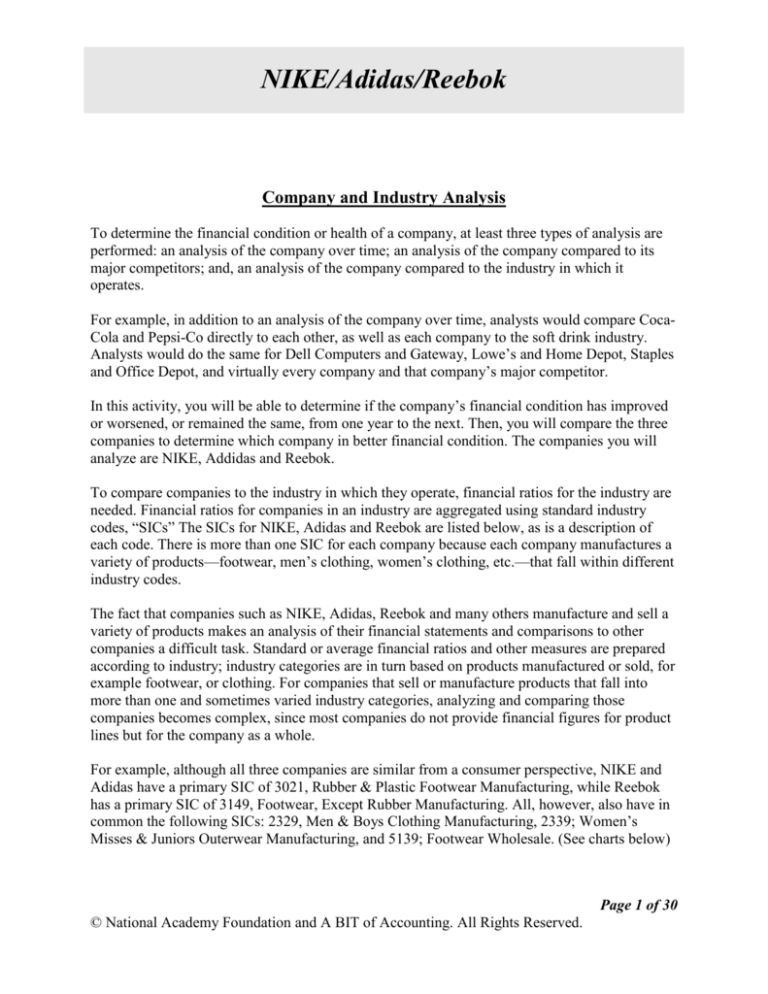
NIKE/Adidas/Reebok
Company and Industry Analysis
To determine the financial condition or health of a company, at least three types of analysis are
performed: an analysis of the company over time; an analysis of the company compared to its
major competitors; and, an analysis of the company compared to the industry in which it
operates.
For example, in addition to an analysis of the company over time, analysts would compare CocaCola and Pepsi-Co directly to each other, as well as each company to the soft drink industry.
Analysts would do the same for Dell Computers and Gateway, Lowe’s and Home Depot, Staples
and Office Depot, and virtually every company and that company’s major competitor.
In this activity, you will be able to determine if the company’s financial condition has improved
or worsened, or remained the same, from one year to the next. Then, you will compare the three
companies to determine which company in better financial condition. The companies you will
analyze are NIKE, Addidas and Reebok.
To compare companies to the industry in which they operate, financial ratios for the industry are
needed. Financial ratios for companies in an industry are aggregated using standard industry
codes, “SICs” The SICs for NIKE, Adidas and Reebok are listed below, as is a description of
each code. There is more than one SIC for each company because each company manufactures a
variety of products—footwear, men’s clothing, women’s clothing, etc.—that fall within different
industry codes.
The fact that companies such as NIKE, Adidas, Reebok and many others manufacture and sell a
variety of products makes an analysis of their financial statements and comparisons to other
companies a difficult task. Standard or average financial ratios and other measures are prepared
according to industry; industry categories are in turn based on products manufactured or sold, for
example footwear, or clothing. For companies that sell or manufacture products that fall into
more than one and sometimes varied industry categories, analyzing and comparing those
companies becomes complex, since most companies do not provide financial figures for product
lines but for the company as a whole.
For example, although all three companies are similar from a consumer perspective, NIKE and
Adidas have a primary SIC of 3021, Rubber & Plastic Footwear Manufacturing, while Reebok
has a primary SIC of 3149, Footwear, Except Rubber Manufacturing. All, however, also have in
common the following SICs: 2329, Men & Boys Clothing Manufacturing, 2339; Women’s
Misses & Juniors Outerwear Manufacturing, and 5139; Footwear Wholesale. (See charts below)
Page 1 of 30
© National Academy Foundation and A BIT of Accounting. All Rights Reserved.
NIKE/Adidas/Reebok
Resources:
The following resources provide industry and company data, such as SICs, to facilitate
comparisons of companies:
The Department of Commerce Financial Report
Robert Morris Associates Annual Statement Studies
Annual Statement Studies
Standard & Poor’s Industry Surveys
Industry Surveys
Almanac of Business and Industrial Financial Ratios
Industry Norms and Key Business Ratios
Value Line Investment Service
In addition, the Money section of www.msn.com provides Industry Ratios. Within the Money
section, click on “Stocks,” then “Research” and then “Key Ratios.” Financial ratios and data for
the company and the industry in which it operates are presented, as well as for the S&P 500.
(The direct link is: http://moneycentral.msn.com/investor/invsub/results/hilite.asp)
Page 2 of 30
© National Academy Foundation and A BIT of Accounting. All Rights Reserved.
NIKE/Adidas/Reebok
Standards Industry Codes (SICs) for NIKE, Adidas and Reebok
Standard Industry Code
3021
3149
2329
2339
5139
SIC 1
SIC 2
SIC 3
SIC 4
Description
Rubber & Plastic Footwear Manufacturing
Footwear, Except Rubber Manufacturing
Men & Boys Clothing Manufacturing
Women’s Misses & Juniors Outerwear Manufacturing
Footwear Wholesale
NIKE
3021
2329
2339
5139
Adidas
3021
2339
2329
5139
Reebok
3149
2329
2339
5139
To view the entire list of SICs, visit the SIC section of the Securities and Exchange
Commission’s (SEC) web site: http://www.sec.gov/info/edgar/siccodes.htm
In addition, more information is available on Webster’s Online Business Directory at
www.webstersonline.com, or http://www.webstersonline.com/siclist.asp or
http://www.webstersonline.com/sic-details.asp#23
Page 3 of 30
© National Academy Foundation and A BIT of Accounting. All Rights Reserved.
NIKE/Adidas/Reebok
PART I – INDIVIDUAL COMPANY ANALYSIS
The objective is to analyze three companies (NIKE/Adidas/Reebok) and determine for each
company the year in which the company was in a better financial condition. This will determine
the financial trend of the company—whether it has improved or worsened, or remained the same,
from one year to the next.
STEP 1:
For each company, calculate the financial ratios for the most current year and the prior year in
each category.
For each ratio, award 1 point for the year—current or prior—in which the ratio was better. Total
the points awarded in each category—profitability, liquidity, debt and productivity.
A maximum of 15 points can be awarded for a particular year. The maximum per category is:
Profitability – 3 points
Liquidity – 7 points
Debt – 3 points
Productivity – 2 points
Complete the short-answer questions that follow each section.
STEP 2:
Copy the total for each category to the Summary table, and calculate the total points awarded for
each year.
STEP 3:
Use your calculations to assess each company’s financial position or condition in each year.
Write a summary that states the year the company’s financial condition was better and an
explanation based on your analysis.
Page 4 of 30
© National Academy Foundation and A BIT of Accounting. All Rights Reserved.
NIKE/Adidas/Reebok
Company Analysis:
NIKE
PROFITABILITY
Current Year
Points
Prior Year
Points
Gross Profit Margin
Operating Profit Margin
Net Profit Margin
Total Points – Profitability
Profitability Analysis
In which year was the company more profitable?
Is the trend in profitability favorable or unfavorable?
Is cost of sales increasing or decreasing as a percentage of sales?
Is operating expenses or selling, general and administrative expenses increasing or
decreasing as a percentage of sales?
Page 5 of 30
© National Academy Foundation and A BIT of Accounting. All Rights Reserved.
NIKE/Adidas/Reebok
Company Analysis:
NIKE
LIQUIDITY
Current Year
Points
Prior Year
Points
Current Ratio
Quick Ratio
Cash Ratio
Working Capital
Inventory Turnover (Days)
Accounts Receivable Turnover (Days)
Operating Cycle (Days)
Total Points - Liquidity
Liquidity Analysis
In which year was the company more liquid?
Is the trend in liquidity favorable or unfavorable?
Which is shorter, the inventory turnover or accounts receivable turnover?
Is it taking more days or less to sell inventory?
Is it taking more days or less to collect accounts receivable?
Is the operating cycle getting longer or shorter?
Why is the operating cycle is getting longer or shorter?
Which is better—the operating cycle or the current, quick and cash ratios?
Page 6 of 30
© National Academy Foundation and A BIT of Accounting. All Rights Reserved.
NIKE/Adidas/Reebok
Company Analysis:
NIKE
DEBT POSITION
Current Year
Points
Prior Year
Points
Debt Ratio
Long-term Debt Ratio
TIE
Total Points – Debt Position
Debt Analysis
In which year is the company’s debt position better?
Is the trend in debt position favorable or unfavorable?
In which year is the company’s ability to pay interest better?
Does the company have more short-term debt (current liabilities) or more long-term debt?
Explain why.
Why is the company’s debt ratio and long-term debt ratio is increasing (decreasing)?
Page 7 of 30
© National Academy Foundation and A BIT of Accounting. All Rights Reserved.
NIKE/Adidas/Reebok
Company Analysis:
NIKE
ASSET PRODUCTIVITY
Current Year
Points
Prior Year
Points
Net Profit Margin
Total Asset Turnover
DuPont Return on Assets
Total Points - Productivity
Asset Productivity Analysis
In which year did the company’s assets generate more sales?
Is the trend in total asset turnover favorable or unfavorable?
In which year did the company have a greater return on assets?
Is the trend in return on assets favorable or unfavorable?
Which is more significant in driving the company’s return on assets—profit margin or
asset turnover? Explain why.
Page 8 of 30
© National Academy Foundation and A BIT of Accounting. All Rights Reserved.
NIKE/Adidas/Reebok
Company Analysis:
NIKE
SUMMARY
Current Year Points
Prior Year Points
Profitability
Liquidity
Debt Position
Asset Productivity
Total Points
Overall Financial Condition Analysis
In which year is the company’s financial condition better?
Is the company’s overall financial condition improving? Explain why.
In which financial areas is the company improving?
Page 9 of 30
© National Academy Foundation and A BIT of Accounting. All Rights Reserved.
NIKE/Adidas/Reebok
Company Analysis:
Adidas
PROFITABILITY
Current Year
Points
Prior Year
Points
Gross Profit Margin
Operating Profit Margin
Net Profit Margin
Total Points – Profitability
Profitability Analysis
In which year was the company more profitable?
Is the trend in profitability favorable or unfavorable?
Is cost of sales increasing or decreasing as a percentage of sales?
Is operating expenses or selling, general and administrative expenses increasing or
decreasing as a percentage of sales?
Page 10 of 30
© National Academy Foundation and A BIT of Accounting. All Rights Reserved.
NIKE/Adidas/Reebok
Company Analysis:
Adidas
LIQUIDITY
Current Year
Points
Prior Year
Points
Current Ratio
Quick Ratio
Cash Ratio
Inventory Turnover (Days)
Accounts Receivable Turnover (Days)
Total Points - Liquidity
Liquidity Analysis
In which year was the company more liquid?
Is the trend in liquidity favorable or unfavorable?
Which is shorter, the inventory turnover or accounts receivable turnover?
Is it taking more days or less to sell inventory?
Is it taking more days or less to collect accounts receivable?
Is the operating cycle getting longer or shorter?
Why is the operating cycle is getting longer or shorter?
Which is better—the operating cycle or the current, quick and cash ratios?
Page 11 of 30
© National Academy Foundation and A BIT of Accounting. All Rights Reserved.
NIKE/Adidas/Reebok
Company Analysis:
Adidas
DEBT POSITION
Current Year
Points
Prior Year
Points
Debt Ratio
Long-term Debt Ratio
TIE
Total Points – Debt Position
Debt Analysis
In which year is the company’s debt position better?
Is the trend in debt position favorable or unfavorable?
In which year is the company’s ability to pay interest better?
Does the company have more short-term debt (current liabilities) or more long-term debt?
Explain why.
Why is the company’s debt ratio and long-term debt ratio is increasing (decreasing)?
Page 12 of 30
© National Academy Foundation and A BIT of Accounting. All Rights Reserved.
NIKE/Adidas/Reebok
Company Analysis:
Adidas
ASSET PRODUCTIVITY
Current Year
Points
Prior Year
Points
Net Profit Margin
Total Asset Turnover
DuPont Return on Assets
Total Points - Productivity
Asset Productivity Analysis
In which year did the company’s assets generate more sales?
Is the trend in total asset turnover favorable or unfavorable?
In which year did the company have a greater return on assets?
Is the trend in return on assets favorable or unfavorable?
Which is more significant in driving the company’s return on assets—profit margin or
asset turnover? Explain why.
Page 13 of 30
© National Academy Foundation and A BIT of Accounting. All Rights Reserved.
NIKE/Adidas/Reebok
Company Analysis:
Adidas
SUMMARY
Current Year Points
Prior Year Points
Profitability
Liquidity
Debt Position
Asset Productivity
Total Points
Overall Financial Condition Analysis
In which year is the company’s financial condition better?
Is the company’s overall financial condition improving? Explain why.
In which financial areas is the company improving?
Page 14 of 30
© National Academy Foundation and A BIT of Accounting. All Rights Reserved.
NIKE/Adidas/Reebok
Company Analysis:
Reebok
PROFITABILITY
Current Year
Points
Prior Year
Points
Gross Profit Margin
Operating Profit Margin
Net Profit Margin
Total Points – Profitability
Profitability Analysis
In which year was the company more profitable?
Is the trend in profitability favorable or unfavorable?
Is cost of sales increasing or decreasing as a percentage of sales?
Is operating expenses or selling, general and administrative expenses increasing or
decreasing as a percentage of sales?
Page 15 of 30
© National Academy Foundation and A BIT of Accounting. All Rights Reserved.
NIKE/Adidas/Reebok
Company Analysis:
Reebok
LIQUIDITY
Current Year
Points
Prior Year
Points
Current Ratio
Quick Ratio
Cash Ratio
Working Capital
Inventory Turnover (Days)
Accounts Receivable Turnover (Days)
Operating Cycle (Days)
Total Points - Liquidity
Liquidity Analysis
In which year was the company more liquid?
Is the trend in liquidity favorable or unfavorable?
Which is shorter, the inventory turnover or accounts receivable turnover?
Is it taking more days or less to sell inventory?
Is it taking more days or less to collect accounts receivable?
Is the operating cycle getting longer or shorter?
Why is the operating cycle is getting longer or shorter?
Which is better—the operating cycle or the current, quick and cash ratios?
Page 16 of 30
© National Academy Foundation and A BIT of Accounting. All Rights Reserved.
NIKE/Adidas/Reebok
Company Analysis:
Reebok
DEBT POSITION
Current Year
Points
Prior Year
Points
Debt Ratio
Long-term Debt Ratio
TIE
Total Points – Debt Position
Debt Analysis
In which year is the company’s debt position better?
Is the trend in debt position favorable or unfavorable?
In which year is the company’s ability to pay interest better?
Does the company have more short-term debt (current liabilities) or more long-term debt?
Explain why.
Why is the company’s debt ratio and long-term debt ratio is increasing (decreasing)?
Page 17 of 30
© National Academy Foundation and A BIT of Accounting. All Rights Reserved.
NIKE/Adidas/Reebok
Company Analysis:
Reebok
ASSET PRODUCTIVITY
Current Year
Points
Prior Year
Points
Net Profit Margin
Total Asset Turnover
DuPont Return on Assets
Total Points - Productivity
Asset Productivity Analysis
In which year did the company’s assets generate more sales?
Is the trend in total asset turnover favorable or unfavorable?
In which year did the company have a greater return on assets?
Is the trend in return on assets favorable or unfavorable?
Which is more significant in driving the company’s return on assets—profit margin or
asset turnover? Explain why.
Page 18 of 30
© National Academy Foundation and A BIT of Accounting. All Rights Reserved.
NIKE/Adidas/Reebok
Company Analysis:
Reebok
SUMMARY
Current Year Points
Prior Year Points
Profitability
Liquidity
Debt Position
Asset Productivity
Total Points
Overall Financial Condition Analysis
In which year is the company’s financial condition better?
Is the company’s overall financial condition improving? Explain why.
In which financial areas is the company improving?
Page 19 of 30
© National Academy Foundation and A BIT of Accounting. All Rights Reserved.
NIKE/Adidas/Reebok
PART II – INDUSTRY & /MAJOR COMPETITOR ANALYSIS
The objective is to analyze each company and determine which company is in better financial
condition, for the current fiscal year and the prior year.
STEP 1:
Use the ratios calculated in Part I. For each ratio, award 3 points to the company with the best
financial ratio. If the “Industry” ratio is the best, award 3 points to the “Industry.”
Award 2 points to the company—or industry—with the second best ratio, and so on. The
company, or the industry, that has the worst ratio receives 0 points.
Total the points awarded in each category—profitability, liquidity, debt and asset productivity.
A maximum of 45 points can be awarded for a particular year. The maximum per category is:
Profitability – 9 points
Liquidity – 21 points
Debt – 9 points
Productivity – 6 points
Answer the short-answer questions that follow each section.
STEP 2:
Copy the total for each category to the Summary table, and calculate the total points awarded for
each company and the industry.
STEP 3:
Use your calculations to assess the company’s financial position relative to each other and to the
industry. Write a summary that compares the financial condition of the companies, addressing
each company in terms of profitability, liquidity, debt and asset productivity. Based on your
analysis, indicate which company is in better financial condition.
Page 20 of 30
© National Academy Foundation and A BIT of Accounting. All Rights Reserved.
NIKE/Adidas/Reebok
Industry & Major Competitor Analysis: NIKE/Adidas/Reebok
(Current Year)
PROFITABILITY
NIKE
Pts
Adidas
Pts
Reebok
Pts
Industry
Gross Profit Margin
Operating Profit Margin
Net Profit Margin
Total Points – Profitability
Profitability Analysis
Which company is most (least) profitable?
Does the company with the highest gross profit margin also have the highest net profit
margin? Explain why.
Does the company with the highest operating profit margin have the highest net profit
margin? Explain why.
Which company has the highest (lowest) cost of sales as a percentage of sales?
Which company has the highest (lowest) operating expense or selling, general and
administrative expenses as a percentage of sales?
Page 21 of 30
© National Academy Foundation and A BIT of Accounting. All Rights Reserved.
Pts
NIKE/Adidas/Reebok
Industry & Major Competitor Analysis: NIKE/Adidas/Reebok
(Current Year)
LIQUIDITY
NIKE
Pts
Adidas
Pts
Reebok
Pts
Industry
Current Ratio
Quick Ratio
Cash Ratio
Working Capital
Inventory Turnover (Days)
Accts. Rec. Turnover (Days)
Operating Cycle (Days)
Total Points – Liquidity
Liquidity Analysis
Which company is the most (least) liquid?
Which company sells its inventory fastest (slowest)?
Which company collects its accounts receivable in the shortest (longest)?
Which company has the shortest (longest) operating cycle? Why? Is it due to a better
inventory turnover or receivable turnover, or both?
Does the company with the shortest (longest) operating cycle also have the best (worst)
current, quick and cash ratios?
Page 22 of 30
© National Academy Foundation and A BIT of Accounting. All Rights Reserved.
Pts
NIKE/Adidas/Reebok
Industry & Major Competitor Analysis: NIKE/Adidas/Reebok
(Current Year)
DEBT POSITION
NIKE
Pts
Adidas
Pts
Reebok
Pts
Industry
Debt Ratio
Long-term Debt Ratio
TIE
Total Points – Debt Position
Debt Analysis
Which company has the best (worst) debt ratio?
Which company has the best (worst) long-term debt ratio?
Which company has the best (worst) ability to pay interest?
Page 23 of 30
© National Academy Foundation and A BIT of Accounting. All Rights Reserved.
Pts
NIKE/Adidas/Reebok
Industry & Major Competitor Analysis: NIKE/Adidas/Reebok
(Current Year)
ASSET PRODUCTIVITY
NIKE
Pts
Adidas
Pts
Reebok
Pts
Industry
Net Profit Margin
Total Asset Turnover
DuPont Return on Assets
Total Points - Productivity
Asset Productivity Analysis
Which company generates the most (least) sales from its assets?
Which company has the best (worst) return on assets?
Page 24 of 30
© National Academy Foundation and A BIT of Accounting. All Rights Reserved.
Pts
NIKE/Adidas/Reebok
Industry & Major Competitor Analysis: NIKE/Adidas/Reebok
(Current Year)
SUMMARY
NIKE
Adidas
Reebok
Industry
Profitability
Liquidity
Debt Position
Asset Productivity
Total Points
Overall Financial Condition Analysis
Which company is in the best (worst) financial condition? Explain why.
Page 25 of 30
© National Academy Foundation and A BIT of Accounting. All Rights Reserved.
NIKE/Adidas/Reebok
Industry & Major Competitor Analysis: NIKE/Adidas/Reebok
(Prior Year)
PROFITABILITY
NIKE
Pts
Adidas
Pts
Reebok
Pts
Industry
Gross Profit Margin
Operating Profit Margin
Net Profit Margin
Total Points – Profitability
Profitability Analysis
Which company is most (least) profitable?
Does the company with the highest gross profit margin also have the highest net profit
margin? Explain why.
Does the company with the highest operating profit margin have the highest net profit
margin? Explain why.
Which company has the highest (lowest) cost of sales as a percentage of sales?
Which company has the highest (lowest) operating expense or selling, general and
administrative expenses as a percentage of sales?
Page 26 of 30
© National Academy Foundation and A BIT of Accounting. All Rights Reserved.
Pts
NIKE/Adidas/Reebok
Industry & Major Competitor Analysis: NIKE/Adidas/Reebok
(Prior Year)
LIQUIDITY
NIKE
Pts
Adidas
Pts
Reebok
Pts
Industry
Current Ratio
Quick Ratio
Cash Ratio
Working Capital
Inventory Turnover (Days)
Accts. Rec. Turnover (Days)
Operating Cycle (Days)
Total Points - Liquidity
Liquidity Analysis
Which company is the most (least) liquid?
Which company sells its inventory fastest (slowest)?
Which company collects its accounts receivable in the shortest (longest)?
Which company has the shortest (longest) operating cycle? Why? Is it due to a better
inventory turnover or receivable turnover, or both?
Does the company with the shortest (longest) operating cycle also have the best (worst)
current, quick and cash ratios?
Page 27 of 30
© National Academy Foundation and A BIT of Accounting. All Rights Reserved.
Pts
NIKE/Adidas/Reebok
Industry & Major Competitor Analysis: NIKE/Adidas/Reebok
(Prior Year)
DEBT POSITION
NIKE
Pts
Adidas
Pts
Reebok
Pts
Industry
Debt Ratio
Long-term Debt Ratio
TIE
Total Points – Debt Position
Debt Analysis
Which company has the best (worst) debt ratio?
Which company has the best (worst) long-term debt ratio?
Which company has the best (worst) ability to pay interest?
Page 28 of 30
© National Academy Foundation and A BIT of Accounting. All Rights Reserved.
Pts
NIKE/Adidas/Reebok
Industry & Major Competitor Analysis: NIKE/Adidas/Reebok
(Prior Year)
ASSET PRODUCTIVITY
NIKE
Pts
Adidas
Pts
Reebok
Pts
Industry
Net Profit Margin
Total Asset Turnover
DuPont Return on Assets
Total Points - Productivity
Asset Productivity Analysis
Which company generates the most (least) sales from its assets?
Which company has the best (worst) return on assets?
Page 29 of 30
© National Academy Foundation and A BIT of Accounting. All Rights Reserved.
Pts
NIKE/Adidas/Reebok
Industry & Major Competitor Analysis: NIKE/Adidas/Reebok
(Prior Year)
SUMMARY
NIKE
Adidas
Reebok
Industry
Profitability
Liquidity
Debt Position
Asset Productivity
Total Points
Overall Financial Condition Analysis
Which company is in the best (worst) financial condition? Explain why.
Page 30 of 30
© National Academy Foundation and A BIT of Accounting. All Rights Reserved.

